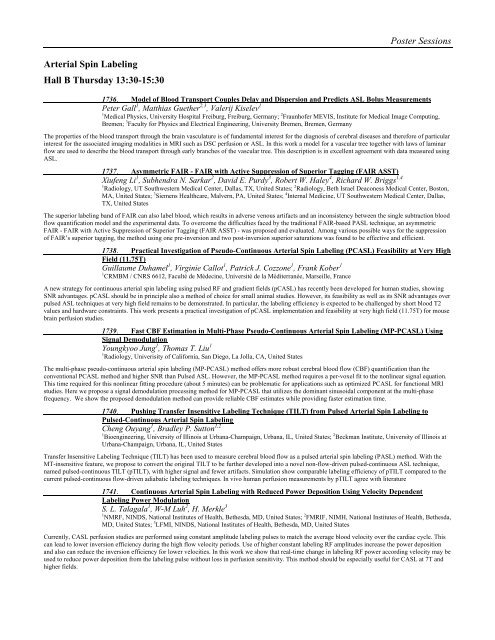TRADITIONAL POSTER - ismrm
TRADITIONAL POSTER - ismrm
TRADITIONAL POSTER - ismrm
Create successful ePaper yourself
Turn your PDF publications into a flip-book with our unique Google optimized e-Paper software.
Poster Sessions<br />
Arterial Spin Labeling<br />
Hall B Thursday 13:30-15:30<br />
1736. Model of Blood Transport Couples Delay and Dispersion and Predicts ASL Bolus Measurements<br />
Peter Gall 1 , Matthias Guether 2,3 , Valerij Kiselev 1<br />
1 Medical Physics, University Hospital Freiburg, Freiburg, Germany; 2 Fraunhofer MEVIS, Institute for Medical Image Computing,<br />
Bremen; 3 Faculty for Physics and Electrical Engineering, University Bremen, Bremen, Germany<br />
The properties of the blood transport through the brain vasculature is of fundamental interest for the diagnosis of cerebral diseases and therefore of particular<br />
interest for the associated imaging modalities in MRI such as DSC perfusion or ASL. In this work a model for a vascular tree together with laws of laminar<br />
flow are used to describe the blood transport through early branches of the vascular tree. This description is in excellent agreement with data measured using<br />
ASL.<br />
1737. Asymmetric FAIR - FAIR with Active Suppression of Superior Tagging (FAIR ASST)<br />
Xiufeng Li 1 , Subhendra N. Sarkar 2 , David E. Purdy 3 , Robert W. Haley 4 , Richard W. Briggs 1,4<br />
1 Radiology, UT Southwestern Medical Center, Dallas, TX, United States; 2 Radiology, Beth Israel Deaconess Medical Center, Boston,<br />
MA, United States; 3 Siemens Healthcare, Malvern, PA, United States; 4 Internal Medicine, UT Southwestern Medical Center, Dallas,<br />
TX, United States<br />
The superior labeling band of FAIR can also label blood, which results in adverse venous artifacts and an inconsistency between the single subtraction blood<br />
flow quantification model and the experimental data. To overcome the difficulties faced by the traditional FAIR-based PASL technique, an asymmetric<br />
FAIR - FAIR with Active Suppression of Superior Tagging (FAIR ASST) - was proposed and evaluated. Among various possible ways for the suppression<br />
of FAIR’s superior tagging, the method using one pre-inversion and two post-inversion superior saturations was found to be effective and efficient.<br />
1738. Practical Investigation of Pseudo-Continuous Arterial Spin Labeling (PCASL) Feasibility at Very High<br />
Field (11.75T)<br />
Guillaume Duhamel 1 , Virginie Callot 1 , Patrick J. Cozzone 1 , Frank Kober 1<br />
1 CRMBM / CNRS 6612, Faculté de Médecine, Université de la Méditerranée, Marseille, France<br />
A new strategy for continuous arterial spin labeling using pulsed RF and gradient fields (pCASL) has recently been developed for human studies, showing<br />
SNR advantages. pCASL should be in principle also a method of choice for small animal studies. However, its feasibility as well as its SNR advantages over<br />
pulsed ASL techniques at very high field remains to be demonstrated. In particular, the labeling efficiency is expected to be challenged by short blood T2<br />
values and hardware constraints. This work presents a practical investigation of pCASL implementation and feasibility at very high field (11.75T) for mouse<br />
brain perfusion studies.<br />
1739. Fast CBF Estimation in Multi-Phase Pseudo-Continuous Arterial Spin Labeling (MP-PCASL) Using<br />
Signal Demodulation<br />
Youngkyoo Jung 1 , Thomas T. Liu 1<br />
1 Radiology, Univerisity of California, San Diego, La Jolla, CA, United States<br />
The multi-phase pseudo-continuous arterial spin labeling (MP-PCASL) method offers more robust cerebral blood flow (CBF) quantification than the<br />
conventional PCASL method and higher SNR than Pulsed ASL. However, the MP-PCASL method requires a per-voxel fit to the nonlinear signal equation.<br />
This time required for this nonlinear fitting procedure (about 5 minutes) can be problematic for applications such as optimized PCASL for functional MRI<br />
studies. Here we propose a signal demodulation processing method for MP-PCASL that utilizes the dominant sinusoidal component at the multi-phase<br />
frequency. We show the proposed demodulation method can provide reliable CBF estimates while providing faster estimation time.<br />
1740. Pushing Transfer Insensitive Labeling Technique (TILT) from Pulsed Arterial Spin Labeling to<br />
Pulsed-Continuous Arterial Spin Labeling<br />
Cheng Ouyang 1 , Bradley P. Sutton 1,2<br />
1 Bioengineering, University of Illinois at Urbana-Champaign, Urbana, IL, United States; 2 Beckman Institute, University of Illinois at<br />
Urbana-Champaign, Urbana, IL, United States<br />
Transfer Insensitive Labeling Technique (TILT) has been used to measure cerebral blood flow as a pulsed arterial spin labeling (PASL) method. With the<br />
MT-insensitive feature, we propose to convert the original TILT to be further developed into a novel non-flow-driven pulsed-continuous ASL technique,<br />
named pulsed-continuous TILT (pTILT), with higher signal and fewer artifacts. Simulation show comparable labeling efficiency of pTILT compared to the<br />
current pulsed-continuous flow-driven adiabatic labeling techniques. In vivo human perfusion measurements by pTILT agree with literature<br />
1741. Continuous Arterial Spin Labeling with Reduced Power Deposition Using Velocity Dependent<br />
Labeling Power Modulation<br />
S. L. Talagala 1 , W-M Luh 2 , H. Merkle 3<br />
1 NMRF, NINDS, National Institutes of Health, Bethesda, MD, United States; 2 FMRIF, NIMH, National Institutes of Health, Bethesda,<br />
MD, United States; 3 LFMI, NINDS, National Institutes of Health, Bethesda, MD, United States<br />
Currently, CASL perfusion studies are performed using constant amplitude labeling pulses to match the average blood velocity over the cardiac cycle. This<br />
can lead to lower inversion efficiency during the high flow velocity periods. Use of higher constant labeling RF amplitudes increase the power deposition<br />
and also can reduce the inversion efficiency for lower velocities. In this work we show that real-time change in labeling RF power according velocity may be<br />
used to reduce power deposition from the labeling pulse without loss in perfusion sensitivity. This method should be especially useful for CASL at 7T and<br />
higher fields.















